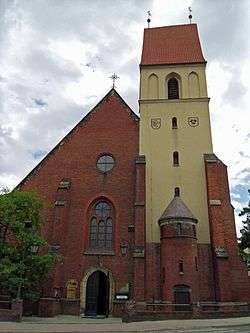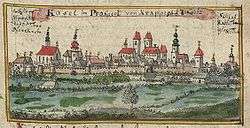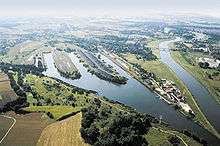Kędzierzyn-Koźle
Kędzierzyn-Koźle [kɛnˈd͡ʑɛʐɨn ˈkɔʑlɛ] (![]()
Kędzierzyn-Koźle | |
|---|---|
 Church of St Sigismund and St Hedwig | |
 Flag  Coat of arms | |
 Kędzierzyn-Koźle  Kędzierzyn-Koźle | |
| Coordinates: 50°21′N 18°12′E | |
| Country | |
| Voivodeship | |
| County | Kędzierzyn-Koźle County |
| Gmina | Kędzierzyn-Koźle (urban gmina) |
| Government | |
| • Mayor | Sabina Nowosielska |
| Area | |
| • Total | 123.42 km2 (47.65 sq mi) |
| Elevation | 180 m (590 ft) |
| Population (2019-06-30[1]) | |
| • Total | 60,852 |
| • Density | 490/km2 (1,300/sq mi) |
| Time zone | UTC+1 (CET) |
| • Summer (DST) | UTC+2 (CEST) |
| Postal code | 47-200, 47-220, 47-232 |
| Car plates & City districts | OK Azoty, Blachownia Śląska, Cisowa, Kędzierzyn, Koźle, Koźle Port, Koźle Rogi, Kłodnica, Kuźniczka, Lenartowice, Miejsce Kłodnickie, Sławięcice |
| Website | http://www.kedzierzynkozle.pl |
- For the Nazi Germany military facilities of Heydebreck, Cosel, and Blechhammer, see Heydebreck-Cosel and Blechhammer.
Geography
Kędzierzyn-Koźle is located in the historic Silesia (Upper Silesia) region at the confluence of the Oder River and its Kłodnica tributary. Situated on the lower reaches of the Gliwice Canal, it is a place of a major river port, has rail connections with all major cities of Poland and serves western outskirts of the Upper Silesian Metropolitan Union. The town is major location of chemical industry, the site of several factories and a power plant at Blachownia Śląska.
In 1975, the historic core Koźle on the left bank of the Oder was merged with the municipalities of Kędzierzyn, Sławięcice (Slawentzitz), and Kłodnica (Koldnitz) on the right shore, which had developed to suburbs since the 19th century industrialisation, to form present-day Kędzierzyn-Koźle.
History
Koźle
A border fortress held by the Polish Piast dynasty was first mentioned in 1104, when it was besieged by the Přemyslid prince Svatopluk of Olomouc. The Koźle castellany was part of the Polish Duchy of Silesia since 1138, from 1172/73 of the Upper Silesian Duchy of Racibórz under the rule of the Silesian Piasts. In 1281, it was inherited by Duke Casimir of Bytom, who also called himself Duke of Koźle. Casimir soon turned to the neighbouring Kingdom of Bohemia; in 1289, he paid homage to King Wenceslaus II and received his duchy as a Bohemian fief. In 1293, he vested Koźle with town privileges, had walls erected. After Casimir was succeeded by his son Władysław in 1312, Koźle remained the capital of an autonomous duchy, ruled by the Bytom branch of the Silesian Piasts until the death of Duke Bolesław in 1355. King Charles IV adjudicated the reverted Bohemian fief to the Piast duke Konrad I of Oleśnica (Oels), whereafter the town remained a possession of the Oleśnica line until it became extinct in 1492.

Again purchased by the Opole duke Jan II the Good in 1509, the Koźle estates were ultimately incorporated into the Lands of the Bohemian Crown upon his death in 1532. Within the Habsburg Monarchy, it was temporarily pawned to the Hohenzollern margraves of Brandenburg-Ansbach. The fortress was besieged several times during the Thirty Years' War and occupied by Danish troops under the command of Duke John Ernest I of Saxe-Weimar in 1627, before they were defeated by Imperial forces under Albrecht von Wallenstein. Again conquered by a Swedish contingent led by Lennart Torstensson in 1642, the town remained almost completely devastated.
Occupied by the troops of King Frederick the Great in the First Silesian War, Cosel with the bulk of Silesia became a Prussian possession by the 1742 Treaty of Breslau. The king ordered the extension of the fortifications, nevertheless the town was occupied by Habsburg Pandurs during the Second Silesian War in 1744 and had to be reconquered by the Prussian Army two years later; the shelling again caused heavy losses and damages. The rebuilt fortress held against Austrian sieges during the Seven Years' War, even General Ernst Gideon von Laudon in 1760 had to raise his siege. In 1807 the Prussian garrison withstood another besiegement by the allied Napoleonic and Bavarian forces under General Bernhard Erasmus von Deroy until a peace was made by the Treaty of Tilsit. In 1815, Cosel was incorporated into the Prussian Province of Silesia. The development of the town was promoted by the construction of the Kłodnica Canal from the Oder port to Gliwice from 1806 until 1907.
After World War I and the Upper Silesia plebiscite of March 1921, the Polish insurgents temporarily captured the part of the town east of the Oder during the Third Silesian Uprising. The Cosel district had a subcamp of Auschwitz III (Monowitz) which operated from April 1, 1944, to January 26, 1945.[2] As part of Silesia, it was among the territories transferred to Poland under the Soviet Union's re-drawing of borders after World War II. In the course of the Vistula–Oder Offensive, the Soviet Red Army from 21 January 1945 attacked the Kosel bridgehead.
Kędzierzyn

Kędzierzyn was founded as a village in the 13th century. During World War II, Sławięcice (German: Slawentziz, Ehrenforst) was the location of two camps of several Arbeitslager Blechhammer labor and POW camps in the area (the crematorium was also in Sławięcice).[3] Kędzierzyn, along with the eastern 25% of Germany's pre-war area was transferred from Germany to Poland as stipulated by the Potsdam Agreement. In the years immediately following World War II, the majority of the area's population, ethnic Germans, was forcibly expelled and their property was expropriated. The area was subsequently repopulated by ethnic Poles, some of whom came from the former eastern territories of Poland.
In 1954, Blachownia and Lenartowice merged to form the Blachownia Śląska district in Sławięcice.
In 1999, the branch line connecting the city with Strzelce Opolskie closed as part of Polskie Koleje Państwowe cost-cutting. In 2003, the Mostostal-Azoty Kędzierzyn-Koźle won the Polish Volleyball League title for the 4th straight year, and in 2006, the Chemik Kędzierzyn-Koźle football team was reactivated.
Notable people
- Bernhard von Hülsen (1865–1950), German general
- Gustav Giemsa (1867-1948), German chemist and bacteriologist
- Tomasz Kamusella (born 1967), Polish scholar
- Patryk Niemiec (born 1997), Polish volleyball player
Twin towns – sister cities
Kędzierzyn-Koźle is twinned with:[4]
References
- "Population. Size and structure and vital statistics in Poland by territorial divison in 2019. As of 30th June". stat.gov.pl. Statistics Poland. 2019-10-15. Retrieved 2020-02-14.
- "6.DV-BEG - Einzelnorm" (in German). Bundesministeriaum der Justiz. Archived from the original on 2009-04-23. Retrieved 2009-12-03.
- tbd. "History of the City". tbd.
- "Miasta partnerskie". kedzierzynkozle.pl (in Polish). Kędzierzyn-Koźle. Retrieved 2020-03-04.
| Wikimedia Commons has media related to Kędzierzyn-Koźle. |
External links
- Jewish Community in Kędzierzyn-Koźle on Virtual Shtetl
